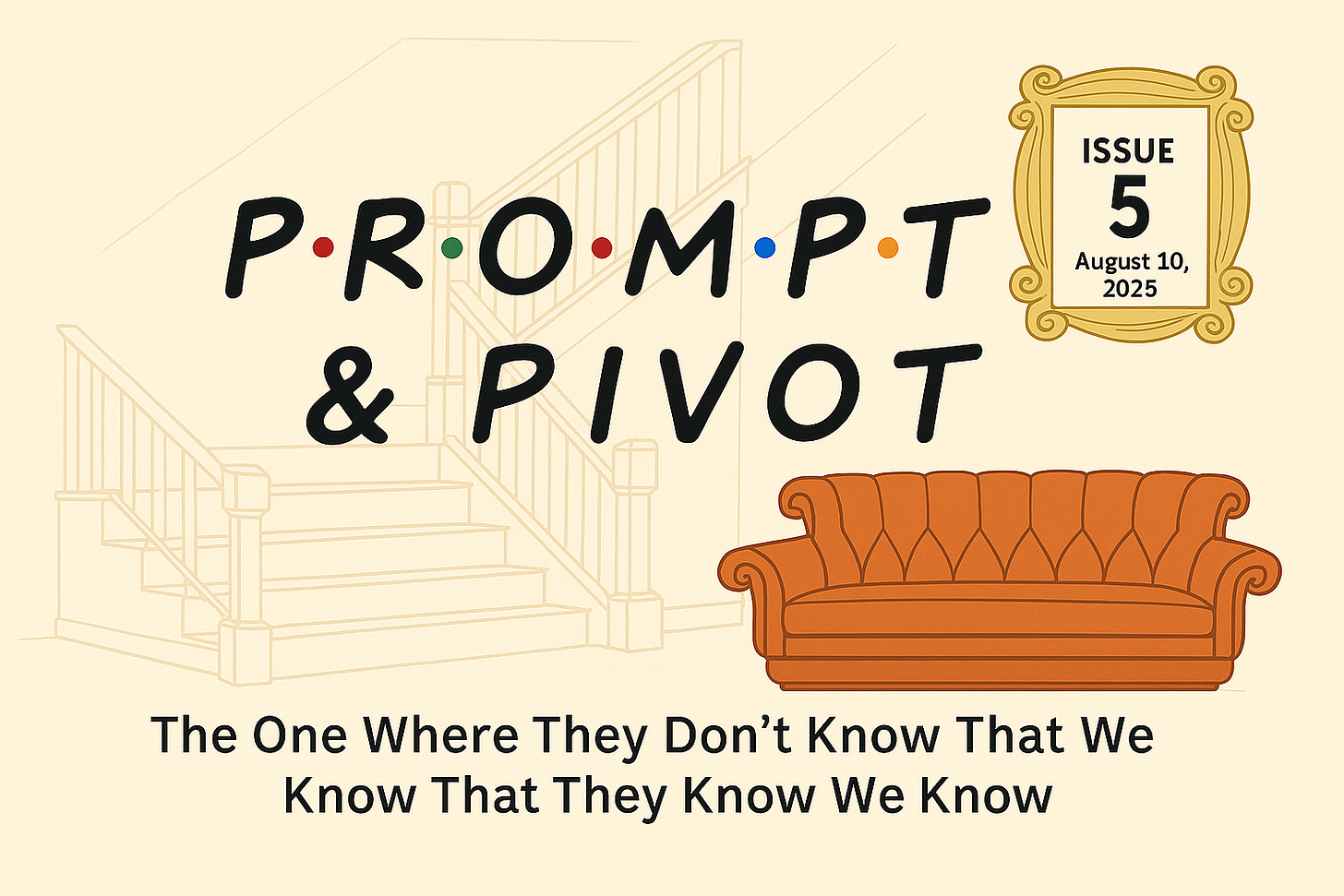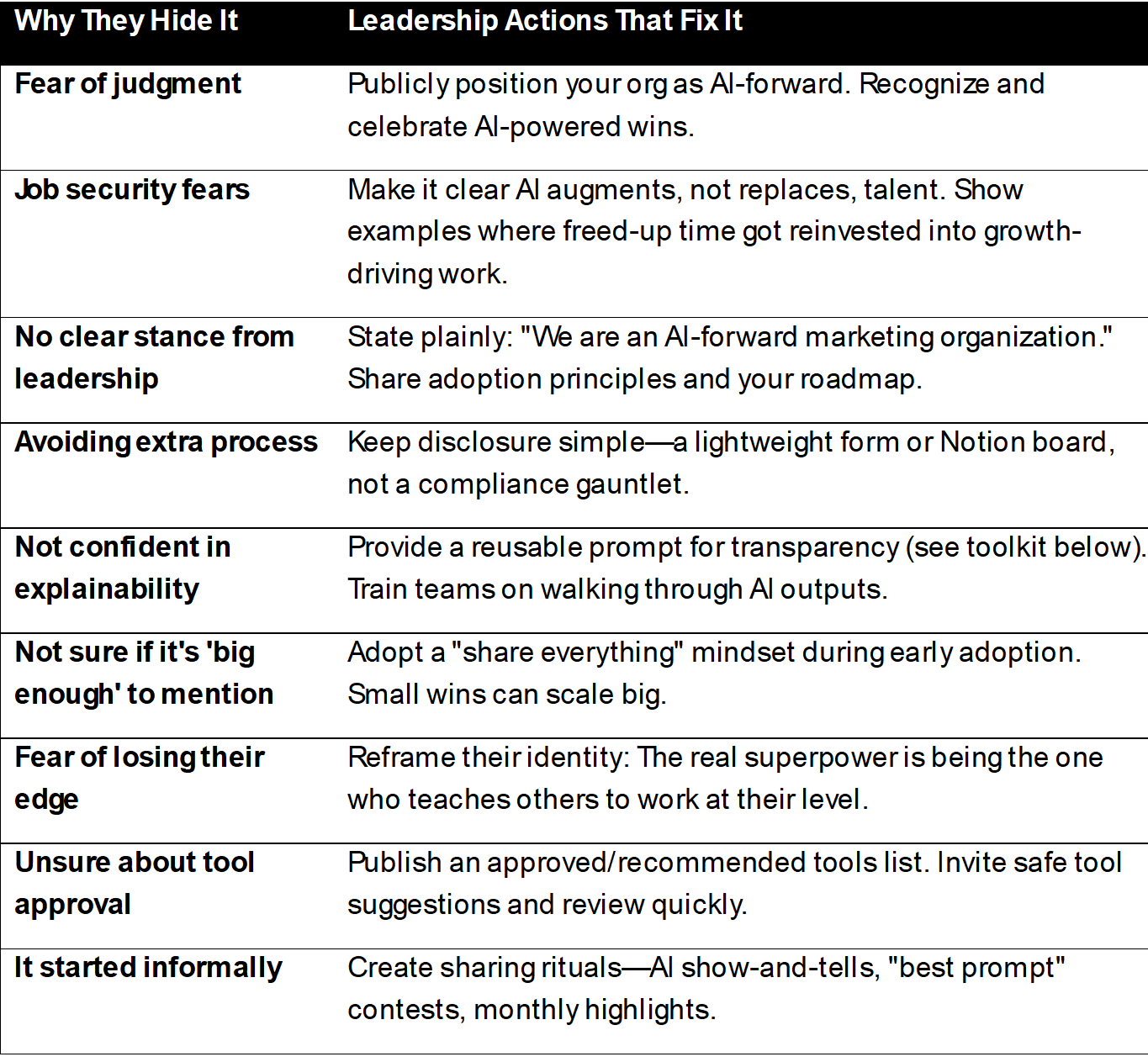The One Where They Don't Know That We Know They Know We Know
Issue 5
Remember that Friends episode where Monica and Chandler think they're keeping their relationship secret… but Joey accidentally finds out? Then Rachel. Then Phoebe. Then it spirals into this high-stakes improv game where everyone is pretending not to know, while actually knowing, while also pretending not to know that the others know.
The longer it goes on, the funnier it gets… in sitcom land.
Now replace "secret relationship" with "how far certain people on your team have taken their AI skills," and the laugh track gets replaced with nervous laughter.
Because here's the truth: You already know everyone's touched AI. Written some copy, polished a headline, maybe authored a blog post or whitepaper.
What you don't know is that your quietest copywriter has built an agent that generates entire research reports, repurposes content into dozens of derivative assets with zero human intervention.
Or that your designer has a PowerPoint machine that cranks out multi-slide decks in under 90 seconds.
Or that your growth manager is running a fully automated ad variation → lead enrichment → CRM upload workflow while you're still on your morning coffee.
Dashboards are appearing in seconds. Campaigns are being tested without anyone touching the ad platform UI.
And the kicker? Your most advanced AI users are often your least vocal about it—because right now, these workflows are their superpower. They're the reason they look like productivity superheroes.
And superheroes don't always hand over their capes.
The Superhuman Trap
If you're a marketing leader, this is the problem:
You don't want a couple of superhumans. You want a superhuman TEAM.
And if you're the "AI whisperer" on the team? Sure—being the tinkerer, the agent builder, the person who can bend ChatGPT to your will is impressive. But you know what's even more career-defining?
Becoming the one who accelerates everyone else's AI adoption.
Because the truth is: In the age of AI, your legacy isn't just the workflows you build… it's the number of people you lift to your level.
The Hidden Cost of "Secret AI"
When advanced AI use stays underground, you lose more than visibility:
No shared learning loop – Game-changing workflows stay locked with a few power users.
Duplicated risk – Rogue agents and tools might be handling sensitive data with no oversight.
Innovation gridlock – Your org never moves from isolated experiments (a.k.a. random acts of AI) to scaled competitive advantage.
Budget sprawl and wasted licensing – Dozens of one-off subscriptions ($20 here, $20 there) pile up. Without a central view, you can't fund intentionally nor can you assess ROI. What’s worse? These subscriptions often comes from program budgets, starving campaigns and hurting ROI on the dollars meant to drive growth.
PIVOT!
Why People Hide AI Use—And How to Fix It
Foundational Enablers for AI Transparency & Collaboration
Declare your stance: "We are an AI-forward marketing organization."
Publish an approved/recommended tools list AND a process to submit for additional tools for review as quick safety checks.
Encourage safe tool sharing: Especially low-risk, high-productivity tools (point solutions) like HeyGen, Descript or WhisperFlow.
Audit for duplication: Consolidate licenses to cut costs and boost collaboration.
Implement AI usage guidelines and data privacy policy: Be explicit about what data can and can't be shared. Believe it or not, putting guardrails in place actually improve adoption as people hesitate out of fear.
Form an AI council: Cross-functional team to guide adoption, governance, and knowledge sharing.
Your AI Transparency Toolkit
1. My Mock AI Council GPT
Get access to my custom AI Advisory Board GPT, pre-loaded with perspectives from my mock AI council. Use it to brainstorm adoption, collaboration, governance, and training ideas for your org.
https://chatgpt.com/g/g-68994879e3208191bf7295cc96871455-mock-ai-advisory-board-public
2. Explainability Notes Prompt for Your Team
Sometimes team members hold back from disclosing their sources because they aren’t confident in the work. Remind your team that they can and should challenge then verify AI output. They can append this to any AI request to make outputs more credible and defensible:
"In addition to your main answer, include a section titled 'Explainability Notes' that contains:
Step-by-step reasoning used to produce the output • All sources consulted or cited, with links where possible
All assumptions made in generating the output • Known gaps or uncertainties that could affect accuracy
Explain the concepts as if I am a 9th grade student.
Write these notes in clear, concise language suitable for review by an executive audience."
Next Week
Next week's episode: The One With the Gym Membership.
You know that Friends episode where Ross and Chandler try to quit the gym… and end up signing more paperwork, getting guilt-tripped by the staff, and walking out with more gym perks than they had before?
That's vendor lock-in with AI or martech contracts.
We'll break down why rigid, long-term deals can be dangerous in a fast-evolving AI landscape, how to spot the fine print that keeps you stuck, and smarter ways to negotiate so you can pivot quickly when the tech moves faster than your contract.
Until then—go make the invisible visible.
—Lisa


